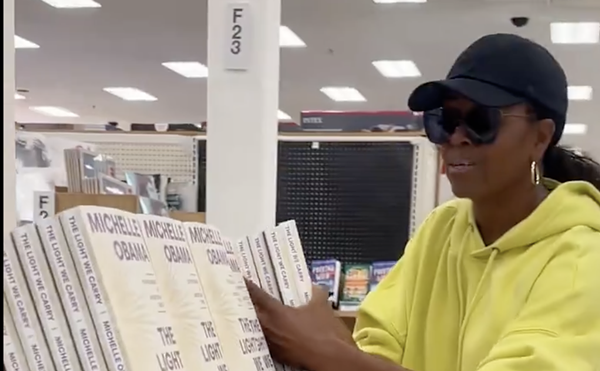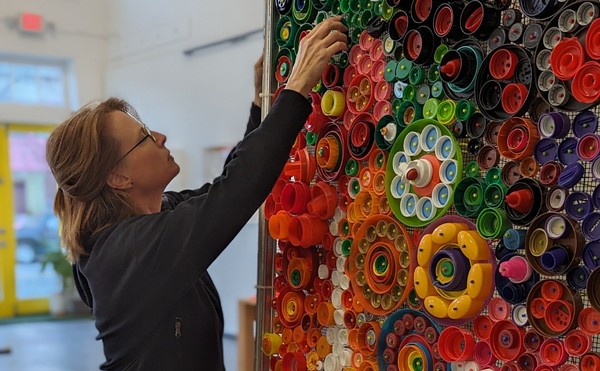The caption came back to me as I took in "American Art of the 1980s," now on view at the Washington University Gallery of Art. Curated by Sabine Eckmann from the Ely and Edythe Broad art collections in Los Angeles, this spare (only fourteen works) but smart exhibition touches on many of the themes we now associate with the decade: theories of postmodernism, critiques of mass media and originality, a new style of political consciousness in art and the return of painting. But another theme undergirds all of these; indeed, it spread through every cultural, social and political event and entity of the 1980s: money.
And it's not a mystery why this occurred. The 1980s was the decade in which capitalism entered its Baroque phase, manifesting itself visually on an unprecedented scale. Imagery ruled, and became the basis for its own economy, in magazines and television, in public signage and in the rise of video. The bustling economy of images naturally found its way into art, with the practices of pastiche, and image appropriation, manipulation and multiplication becoming the order of the day.
In "American Art of the 1980s," Mark Tansey and David Salle are represented by paintings that employ these practices to exceptional effect. Tansey's Four Forbidden Senses (Taste, Sound, Smell, Touch) from 1982 is a huge quadriptych, with each of the senses demonstrated in a separate panel. The scenes might be mistaken for stills from a 1950s B-movie. The imagery in Salle's triptych Pound Notes (1986) is more elusive, grafting painted Baroque escutcheons over the figures of women who are rendered in different painting styles (photorealism, expressionism), while the center panel features a young boy painted in the style of a Cartier-Bresson photograph. In Salle's work, there is no "correct" way to read the painting; instead there is the suggestion of meaning in flux, as styles and symbols are dislodged from their histories and treated like free-floating signifiers at play on the canvas.
Tansey and Salle were part of the return to painting that marked the 1980s, as were Eric Fischl and Julian Schnabel, who were given credit for branding new styles of expressionism. Fischl's scenes of suburban psychosexual angst gained him considerable fame in the 1980s, but his painting in this exhibition, The Evacuation of Saigon (1987), tackles history on a grander scale. Self-Portrait in Andy's Shadow (1987) is vintage Schnabel, bombastic in scale and full of his expressionist trademarks -- broken crockery and an awkward, vulnerable figurative style.
The inclusion of Schnabel in this exhibition inevitably evokes the art market of the 1980s, for Schnabel's career mirrored the economic climate of the decade. In the early 1980s, Schnabel signed on with then-novice New York gallery owner Mary Boone. Through aggressive marketing and savvy connections, they parlayed his art into a multimillion-dollar business (there were waiting lists for paintings he had yet to produce). Schnabel wasn't alone; scores of artists made fortunes in the 1980s. Reaganomics had made the rich even richer, and art became an investment that seemed safer than the stock market.
The art market actually resembled the stock market in many ways in the 1980s. It was cutthroat and competitive, run by brokers and clients who bought and sold art at massively inflated prices. Robert Longo's brilliant photo-based drawings neatly conflate the worlds of art and economics, and Untitled (White Riot Series) (1982), included in this exhibition, is one of his best. The large diptych shows five yuppie types, fashionably clad in black and white, locked in a violent physical struggle. They could be stockbrokers who let market pressure get to them, or they could be gallery-goers, fighting their way into a crowded opening. (The figures are, in fact, based on a few of Longo's artist friends.)
Curator Sabine Eckmann correctly points out that the decade of the 1980s was "a time in which the most diverse artistic practices coexisted simultaneously." What partly accounts for this is the market itself and its need for new blood, new styles and new names to sell. Countercultural practices like punk, graffiti and other forms of street art were subsumed into the market, turning artists like Keith Haring and Jean-Michel Basquiat into (somewhat reluctant) art superstars. In this exhibition, Haring's Red Room (1988) and Basquiat's Untitled (Skull) (1981) and Horn Players (1983) leave little doubt as to the artists' considerable creative talents, but they're also reminders of the astonishing speed with which careers could be established in that decade.
One artist who was not reluctant at all about becoming an art superstar was Jeff Koons. As a former stockbroker, Koons actually managed to out-Warhol even Warhol in making art a business. But beyond marketing his art and marketing himself (which he did brilliantly), Koons proved to have an uncanny ability to identify the kitsch aesthetic sublimated in high art, as well as the profoundly metaphysical character of mass-produced commodities. In this exhibition, we're treated to examples of both. Three Ball 50/50 Tank (1985) has basketballs poised in perfect equilibrium within a water tank, as if they have achieved a state of nirvana. Italian Woman (1986) and Louis XIV (1986) are stainless-steel casts of Baroque portrait busts that beautifully enhance the aesthetic cheesiness of the original sculptures.
Works by quintessential '80s artists Sherri Levine, Ross Bleckner and Jack Goldstein round out this exhibition, which, while small, manages to encompass the quintessential themes of art in that decade. Of these, the theme of money -- that is, the national economy, the art market, ideas of value and worth -- seems to stand out in particular. Economic forces are determinants of cultural production in any era, to be sure. But in retrospect, culture in the 1980s seems more visibly decadent, and more explicit about the economic forces that drove it, than in any other period in memory. Thank God it's over, and we live in an era that's not about the money.
Showing in the lower galleries in Steinberg Auditorium are two more exhibitions of American art, "Painting America in the 19th Century" and "American Art on Paper from the 1960s to the Present." Both of these provide fascinating counterpoints to the 1980s exhibition and show off pieces from Washington University's formidable art collection that are otherwise rarely seen.





